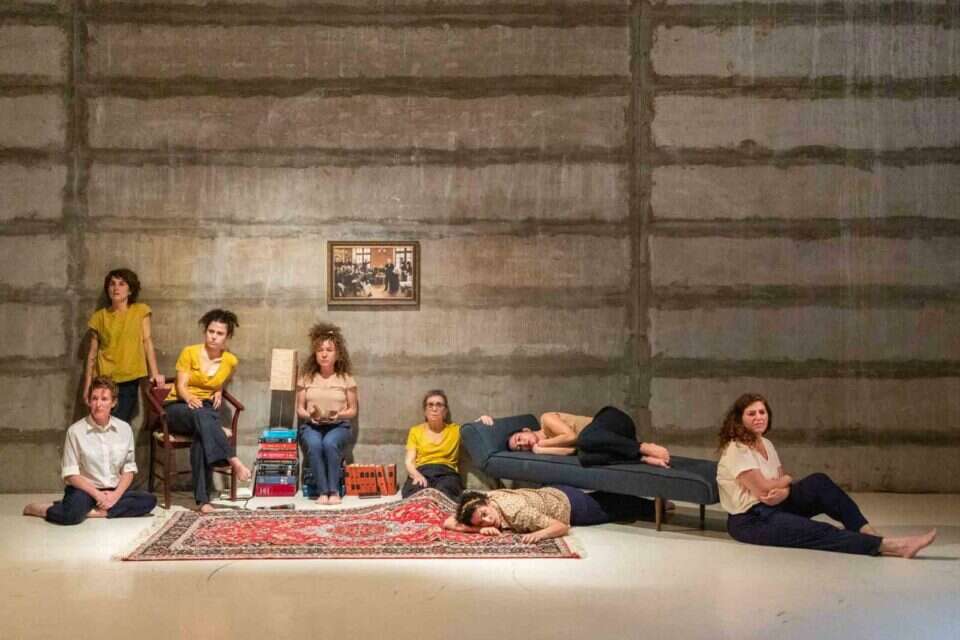"It is no longer possible to close our eyes and repress, we have to deal with the sick evils in society - exploitation and the gender power relations that exist even today in every place, configuration or sector. My job as an artist is to create works that reflect and elevate these contents."
So says Adili Lieberman, a creator, actress and improvisation teacher, who is currently presenting her new work "Hysteria Shows - Chapter 2", which premiered at the "Tools" festival, and brings the trauma and post-trauma to the forefront through the bodies of the therapists who meet them in their daily work.
Lieberman's social and creative "seismograph" pinpoints the frequencies of reality.
As evidence, despite the work of the #MeToo movement in promoting the safety of women in the professional and personal space, only a month ago the US Supreme Court overturned the historic ruling of Roe v. Wade from 1973 which allowed abortions, thus denying women the right to decide about their bodies. The news that There is still a long way to charge the discourse of women and women all over the world, but it is clear that alongside the legal layers, the flooding of the experience of the body in situations of violence and oppression, hidden as well as visible, and bringing it out of the shadows of silencing is mainly required.
In the arenas of dance and performance - arts in which the living body is the instrument as well as the content of the show - a recent trend of proactive diving into the deep and fragile resolutions of the body can be detected in order to voice what is not spoken enough.
Lieberman's work is a living example of this, which not only presents in a bare and shocking way physical manifestations of trauma and post-trauma, but makes the very act of talking about this physical-emotional state, among other things, to break down the repression and shame that accompany it.
"A great contribution from physical research".
From the rehearsals, photo: Eil Tager
"The Shows of Hysteria - Chapter 2" brings the open wound of trauma and post-trauma from a contemporary perspective, which clearly shows that "this substance of hysteria is primordial, temporary and eternal, and weaves within it the story of patriarchy concisely", as Lieberman claims.
Eight movement therapists, physical therapists and psychologists participate with her in the show, most of them work or have worked in psychiatric wards and some also have a background in dance.
Lieberman defines the transition to working with a community of caregivers as "almost natural", and explains that it arose from the need to include recovery, treatment and healing in the trauma equation.
This motivation was also significant in the therapists' experience: Orit Gross, a movement therapist and psychotherapist, saw the first version of the work and explains that chapter two allowed her to "give testimony to the body present in the trauma and in front of it. I know the aspects (disconnections, paralysis, fainting, etc.) from the clinic It was a conscious decision to let my body speak them, the symptoms through which they cry out their pain, to allow the inaudible language to be seen."
From observation to identification
The consent to this physical embodiment is in many respects a refined act of compassion, which is heart-wrenching and impossible to remain indifferent to.
Artistically, it adds another layer to the reflection: the observation of caregivers sharpens for the audience their place in the living archive of trauma and post-trauma, and their role in creating a revised body of knowledge for this situation, which is not only "looked at" but "experienced from within".
"Frightening, threatening and intriguing"
Not by chance, the show brings them together with their other work: Zohar Minkovich, a movement therapist, testifies that "embodying the movement expression of the hysteria disorder was sometimes frightening, threatening, intriguing, confusing and instructive. As a therapist, I benefited greatly from the process";
Irena Payok, a physical therapist, also says that "engaging in physical research has given me a wider and sharper lens to see those who come to me. I hear what is said to me differently - also the intervals, the silences, the breaths. I give them space and validity."
Lieberman.
"Taking responsibility for recovery",
In "Laughter of the Medusa", one of the founding texts of feminism, the essayist Hélène Cixault coined the term "feminine writing" (écriture féminine) as a response to the silencing of the body by the systems of patriarchal society, and called on women to return to their bodies and speak them: "Write yourself: on your body to make his voice heard."
In "Hysteria Shows - Chapter 2", Adili Lieberman and the therapists she accompanies free the damaged body-mind from the destructive voyeurism of the past, and rewrite their story from the wisdom of a body that really sees the pain and listens to those who are in pain.
This is a performative correction, and above all humanistic values to a sick system, and for Lieberman it is "taking responsibility for the recovery and hope, to make the transformative move from diving into the abyss to the ability to contain and breathe."
Regular and deep breathing after watching the show takes a little more time.
Creator: Adili Lieberman
Performers: Irena Payok, Orit Gross, Zohar Minkovich, Alexandra Odi, Gilat Amutz Student, Vicky Hait, Ariela Ossi, Adili Lieberman.
were we wrong
We will fix it!
If you found an error in the article, we would appreciate it if you shared it with us

